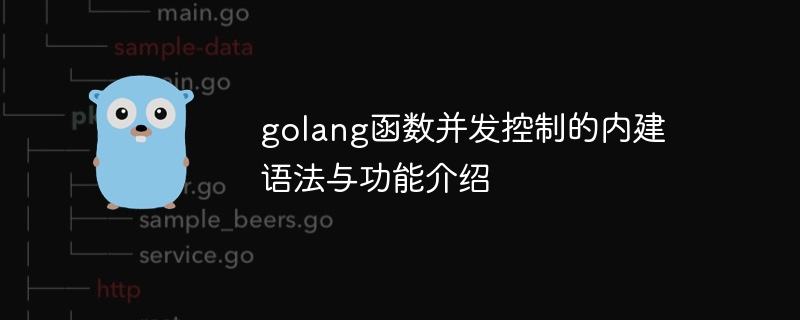Home >Backend Development >Golang >Introduction to the built-in syntax and functions of golang function concurrency control
Introduction to the built-in syntax and functions of golang function concurrency control
- WBOYWBOYWBOYWBOYWBOYWBOYWBOYWBOYWBOYWBOYWBOYWBOYWBOriginal
- 2024-04-24 18:03:01955browse
Go language controls function concurrency through built-in syntax, including: go func() creates Goroutine, sync.Mutex mutex protects shared data, sync.WaitGroup wait group coordinates Goroutine execution, and sync.Cond condition variable cooperative control. These built-in syntaxes support concurrent execution, data protection and collaborative control, optimizing program performance. The case of parallel computing of Fibonacci sequences demonstrates its practical application.

Introduction to the built-in syntax and functions of Go language function concurrency control
Concurrency in the Go language is implemented through Goroutine. Goroutine It is a lightweight thread in Go language. By using Goroutine, we can write concurrent programs to take full advantage of multi-core CPUs and improve program performance.
Built-in syntax
The Go language provides the following built-in syntax to control function concurrency:
- go func(): Create a new Goroutine, which will execute the func function concurrently.
- sync.Mutex: Mutex lock, used to protect shared data.
- sync.WaitGroup: Waiting group, used to wait for a group of Goroutines to complete.
- sync.Cond: Condition variable, used to coordinate collaboration between Goroutines.
Features
These built-in syntaxes provide the following functionality:
- Concurrent execution: Can be run in parallel Execute multiple Goroutines to fully utilize multi-core CPU resources.
- Data Protection: Mutex locks can ensure that shared data is only accessed by one Goroutine at the same time to prevent data corruption.
- Collaboration control: Waiting groups and condition variables can control the collaboration between Goroutines to ensure that they are executed in the correct order.
Practical Case
The following is a practical case for calculating the Fibonacci sequence, demonstrating how to use Goroutine for concurrent calculations:
package main
import (
"fmt"
"sync"
)
// 计算斐波那契数列
func fibonacci(n int) int {
if n <= 1 {
return n
}
return fibonacci(n-1) + fibonacci(n-2)
}
func main() {
// 创建互斥锁保护计数器
var mu sync.Mutex
// 创建等待组等待所有 Goroutine 完成
var wg sync.WaitGroup
// 并发计算斐波那契数列
for i := 0; i < 10; i++ {
wg.Add(1)
go func(i int) {
defer wg.Done()
result := fibonacci(i)
// 使用互斥锁保护计数器
mu.Lock()
fmt.Printf("Fibonacci(%d) = %d\n", i, result)
mu.Unlock()
}(i)
}
// 等待所有 Goroutine 完成
wg.Wait()
}This program will calculate the first 10 numbers of the Fibonacci sequence in parallel and use a mutex to protect the output to ensure that each number is printed in order.
The above is the detailed content of Introduction to the built-in syntax and functions of golang function concurrency control. For more information, please follow other related articles on the PHP Chinese website!

